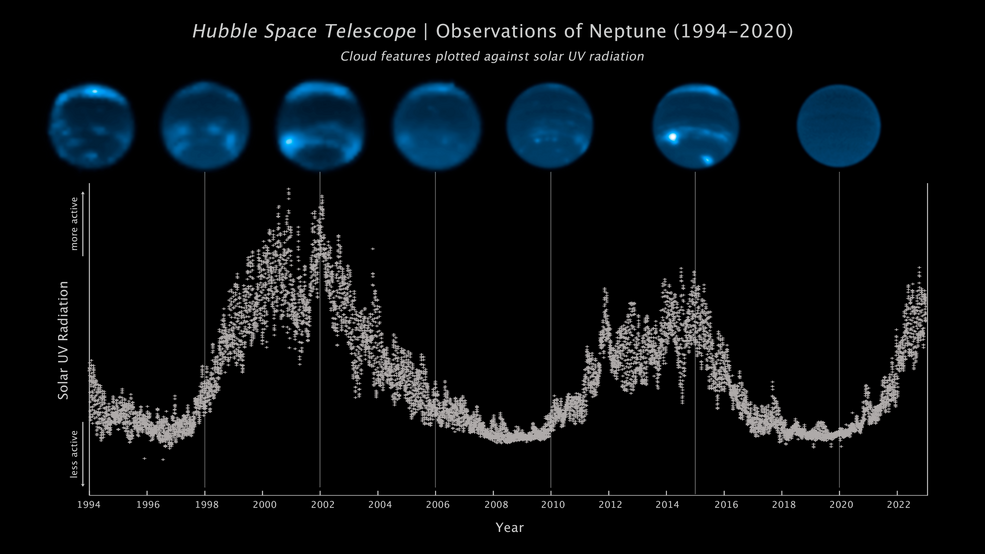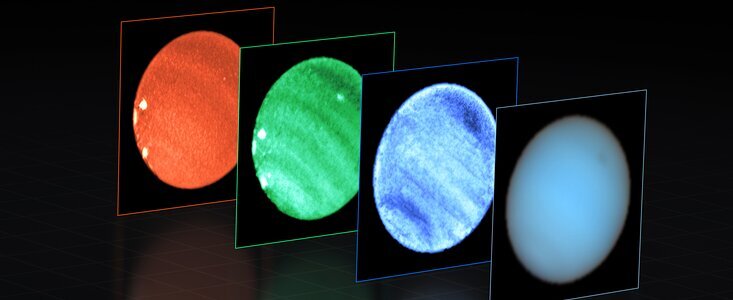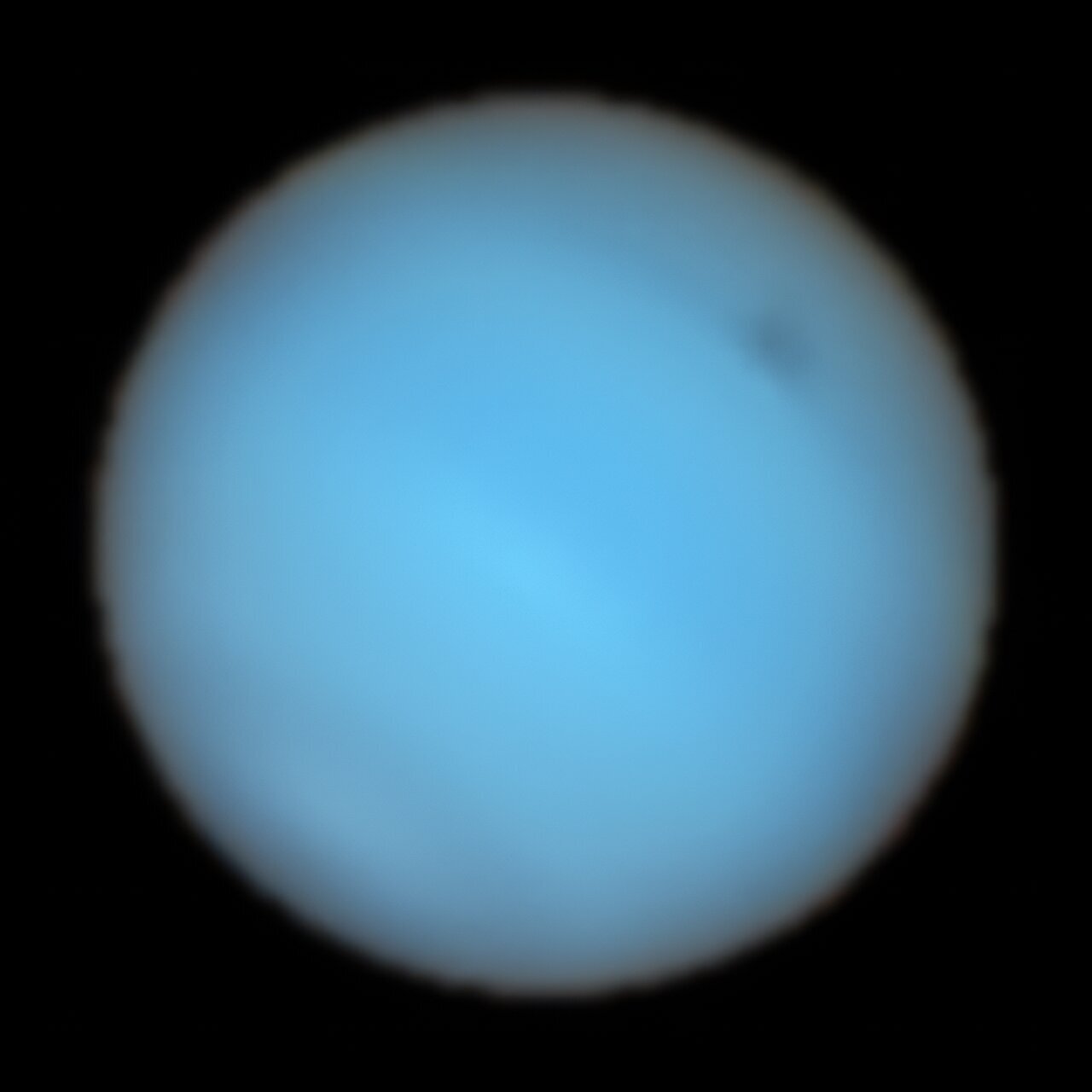19.08.2023
Astronomers have uncovered a link between Neptune's shifting cloud abundance and the 11-year solar cycle, in which the waxing and waning of the Sun's entangled magnetic fields drives solar activity.
This discovery is based on three decades of Neptune observations captured by NASA's Hubble Space Telescope and the W. M. Keck Observatory in Hawaii, as well as data from the Lick Observatory in California.

The link between Neptune and solar activity is surprising to planetary scientists because Neptune is our solar system's farthest major planet and receives sunlight with about 0.1% of the intensity Earth receives. Yet Neptune's global cloudy weather seems to be driven by solar activity, and not the planet's four seasons, which each last approximately 40 years.
At present, the cloud coverage seen on Neptune is extremely low, with the exception of some clouds hovering over the giant planet's south pole. A University of California (UC) Berkeley-led team of astronomers discovered that the abundance of clouds normally seen at the icy giant's mid-latitudes started to fade in 2019.
"I was surprised by how quickly clouds disappeared on Neptune," said Imke de Pater, emeritus professor of astronomy at UC Berkeley and senior author of the study. "We essentially saw cloud activity drop within a few months," she said.
"Even now, four years later, the most recent images we took this past June still show the clouds haven't returned to their former levels," said Erandi Chavez, a graduate student at the Center for Astrophysics | Harvard-Smithsonian (CfA) in Cambridge, Massachusetts, who led the study when she was an undergraduate astronomy student at UC Berkeley. "This is extremely exciting and unexpected, especially since Neptune's previous period of low cloud activity was not nearly as dramatic and prolonged."
To monitor the evolution of Neptune's appearance, Chavez and her team analyzed Keck Observatory images taken from 2002 to 2022, the Hubble Space Telescope archival observations beginning in 1994, and data from the Lick Observatory in California from 2018 to 2019.
In recent years, the Keck observations have been complemented by images taken as part of the Twilight Zone program and by Hubble's Outer Planet Atmospheres Legacy (OPAL) program.
The images reveal an intriguing pattern between seasonal changes in Neptune’s cloud cover and the solar cycle – the period when the Sun's magnetic field flips every 11 years as it becomes more tangled like a ball of yarn. This is evident in the increasing number of sunspots and increasing solar flare activity. As the cycle progresses, the Sun’s tempestuous behavior builds to a maximum, until the magnetic field beaks down and reverses polarity. Then the Sun settles back down to a minimum, only to start another cycle.

When it's stormy weather on the Sun, more intense ultraviolet (UV) radiation floods the solar system. The team found that two years after the solar cycle's peak, an increasing number of clouds appear on Neptune. The team further found a positive correlation between the number of clouds and the ice giant's brightness from the sunlight reflecting off it.
"These remarkable data give us the strongest evidence yet that Neptune's cloud cover correlates with the Sun’s cycle," said de Pater. "Our findings support the theory that the Sun's UV rays, when strong enough, may be triggering a photochemical reaction that produces Neptune’s clouds."
Scientists discovered the connection between the solar cycle and Neptune's cloudy weather pattern by looking at 2.5 cycles of cloud activity recorded over the 29-year span of Neptunian observations. During this time, the planet's reflectivity increased in 2002 then dimmed in 2007. Neptune became bright again in 2015, then darkened in 2020 to the lowest level ever observed, which is when most of the clouds went away.
The changes in Neptune's brightness caused by the Sun appear to go up and down relatively in sync with the coming and going of clouds on the planet. However there is a two-year time lag between the peak of the solar cycle and the abundance of clouds seen on Neptune. The chemical changes are caused by photochemistry, which happens high in Neptune's upper atmosphere and takes time to form clouds.
"It's fascinating to be able to use telescopes on Earth to study the climate of a world more than 2.5 billion miles away from us," said Carlos Alvarez, staff astronomer at Keck Observatory and co-author of the study. "Advances in technology and observations have enabled us to constrain Neptune's atmospheric models, which are key to understanding the correlation between the ice giant's climate and the solar cycle."
However, more work is necessary. For example, while an increase in UV sunlight could produce more clouds and haze, it could also darken them, thereby reducing Neptune's overall brightness. Storms on Neptune rising up from the deep atmosphere affect the cloud cover, but are not related to photochemically produced clouds, and hence may complicate correlation studies with the solar cycle. Continued observations of Neptune are also needed to see how long the current near-absence of clouds will last.
The research team continues to track Neptune's cloud activity. "We have seen more clouds in the most recent Keck images that were taken during the same time NASA's James Webb Space Telescope observed the planet; these clouds were in particular seen at northern latitudes and at high altitudes, as expected from the observed increase in the solar UV flux over the past approximately 2 years," said de Pater.
The combined data from Hubble, the Webb Space Telescope, Keck Observatory, and the Lick Observatory will enable further investigations into the physics and chemistry that lead to Neptune's dynamic appearance, which in turn may help deepen astronomers' understanding not only of Neptune, but also of exoplanets, since many of the planets beyond our solar system are thought to have Neptune-like qualities.
The findings are published in the journal Icarus.
The Hubble Space Telescope is a project of international cooperation between NASA and ESA. NASA's Goddard Space Flight Center in Greenbelt, Maryland, manages the telescope. The Space Telescope Science Institute (STScI) in Baltimore conducts Hubble science operations. STScI is operated for NASA by the Association of Universities for Research in Astronomy, in Washington, D.C.
Mysterious Neptune dark spot detected from Earth for the first time


This image shows Neptune observed with the MUSE instrument at ESO’s Very Large Telescope. At each pixel within Neptune, MUSE splits the incoming light into its constituent colours or wavelengths. This is similar to obtaining images at thousands of different wavelengths all at once, which provides a wealth of valuable information to astronomers. This image combines all colours captured by MUSE into a “natural” view of Neptune, where a dark spot can be seen to the upper-right.
Using ESO’s Very Large Telescope (VLT), astronomers have observed a large dark spot in Neptune’s atmosphere, with an unexpected smaller bright spot adjacent to it. This is the first time a dark spot on the planet has ever been observed with a telescope on Earth. These occasional features in the blue background of Neptune’s atmosphere are a mystery to astronomers, and the new results provide further clues as to their nature and origin.
Large spots are common features in the atmospheres of giant planets, the most famous being Jupiter’s Great Red Spot. On Neptune, a dark spot was first discovered by NASA’s Voyager 2 in 1989, before disappearing a few years later. “Since the first discovery of a dark spot, I’ve always wondered what these short-lived and elusive dark features are,” says Patrick Irwin, Professor at the University of Oxford in the UK and lead investigator of the study published today in Nature Astronomy.
Irwin and his team used data from ESO’s VLT to rule out the possibility that dark spots are caused by a ‘clearing’ in the clouds. The new observations indicate instead that dark spots are likely the result of air particles darkening in a layer below the main visible haze layer, as ices and hazes mix in Neptune’s atmosphere.
Coming to this conclusion was no easy feat because dark spots are not permanent features of Neptune’s atmosphere and astronomers had never before been able to study them in sufficient detail. The opportunity came after the NASA/ESA Hubble Space Telescope discovered several dark spots in Neptune's atmosphere, including one in the planet’s northern hemisphere first noticed in 2018. Irwin and his team immediately got to work studying it from the ground — with an instrument that is ideally suited to these challenging observations.
Using the VLT’s Multi Unit Spectroscopic Explorer (MUSE), the researchers were able to split reflected sunlight from Neptune and its spot into its component colours, or wavelengths, and obtain a 3D spectrum [1]. This meant they could study the spot in more detail than was possible before. “I’m absolutely thrilled to have been able to not only make the first detection of a dark spot from the ground, but also record for the very first time a reflection spectrum of such a feature,” says Irwin.
Since different wavelengths probe different depths in Neptune’s atmosphere, having a spectrum enabled astronomers to better determine the height at which the dark spot sits in the planet's atmosphere. The spectrum also provided information on the chemical composition of the different layers of the atmosphere, which gave the team clues as to why the spot appeared dark.
The observations also offered up a surprise result. “In the process we discovered a rare deep bright cloud type that had never been identified before, even from space,” says study co-author Michael Wong, a researcher at the University of California, Berkeley, USA. This rare cloud type appeared as a bright spot right beside the larger main dark spot, the VLT data showing that the new ‘deep bright cloud’ was at the same level in the atmosphere as the main dark spot. This means it is a completely new type of feature compared to the small ‘companion’ clouds of high-altitude methane ice that have been previously observed.
With the help of ESO’s VLT, it is now possible for astronomers to study features like these spots from Earth. “This is an astounding increase in humanity’s ability to observe the cosmos. At first, we could only detect these spots by sending a spacecraft there, like Voyager. Then we gained the ability to make them out remotely with Hubble. Finally, technology has advanced to enable this from the ground,” concludes Wong, before adding, jokingly: "This could put me out of work as a Hubble observer!”
Notes
[1] MUSE is a 3D spectrograph that allows astronomers to observe the entirety of an astronomical object, like Neptune, in one go. At each pixel, the instrument measures the intensity of light as a function of its colour or wavelength. The resulting data form a 3D set in which each pixel of the image has a full spectrum of light. In total, MUSE measures over 3500 colours. The instrument is designed to take advantage of adaptive optics, which corrects for the turbulence in the Earth’s atmosphere, resulting in sharper images than otherwise possible. Without this combination of features, studying a Neptune dark spot from the ground would not have been possible.
Quelle: ESO
